|
⇐ Previous Article — Table of Contents — Next Article ⇒
New Energy Times home page
19. Two Decades of “Cold Fusion”
By Steven B. Krivit
The Birth of "Cold Fusion"
"Cold fusion" was born on March 23, 1989, from the research of electrochemists Martin Fleischmann and Stanley Pons.
It was named in a Wall Street Journal article, but it was known by many other names: "The Scientific Fiasco of the Century," "Bad Science" and "Voodoo Science."
When "cold fusion" arrived on the world's doorstep, it was a surprise to all but a handful of people. Throughout the past two decades, it has continued to offer surprises.
The history of "cold fusion" contains a rich collection of real-life examples from which to study science at and beyond the leading edge. The current lessons on "cold fusion" given in academic instructional materials – based on 17-year-old references – are outdated and incomplete. A new wave of scholars is beginning to re-examine the subject with fresh eyes and information and with the much clearer view that hindsight provides.
This article builds on all the previous articles from this special report to offer one perspective on some of the major factors and turning points in the field. Because I have been a direct witness to the last decade and have met nearly all the major players, the second decade of "cold fusion" is most familiar to me.
1989 - Enter "Cold Fusion"
It was all mainstream science could do to suspend disbelief when Fleischmann and Pons appeared on the evening of March 23, 1989, by satellite on the MacNeil/Lehrer News Hour.
As has been reported in many books (Krivit and Winocur, Beaudette, Mallove), the 1989 "cold fusion" critics led the public and the scientific world to believe that the idea of "cold fusion" was entirely without merit; this had a profound and lasting effect.
"The anti-cold fusion crowd was equally guilty, if you believe another of the solemn canons: ... Science must be firmly rooted in experiment or observation, unladen with theoretical preconceptions," Caltech professor David Goodstein wrote at the time.
No one has better characterized the devastating effects of these angry scientists at the May 1-2, 1989, American Physical Society meeting than Goodstein.
"Although there were numerous presentations at this session," he wrote, "only two really counted. Steven Koonin and Nathan Lewis, speaking for himself and Charles Barnes – all three from Caltech – executed between them a perfect slam-dunk that cast cold fusion right out of the arena of mainstream science."
Not only was the nascent science delayed as a result of this hostility, but also many of the brilliant men and women who have courageously explored the field have suffered severe consequences as a result. In some cases, the stories are heartbreaking.
Some of the 1989 critics, particularly the theorists of the day, said the idea of "cold fusion" was wrong because it didn't agree with their understanding of fusion. They forgot the scientific process: Experiment trumps theory.
For a short while, the paradigm of "cold fusion" disrupted the paradigm of thermonuclear fusion. The term "hot fusion" became part of the vocabulary only after March 23, 1989.
The next decade brought significant breadth to the understanding of LENR, including a wide spectrum of measured phenomena. However, the field remains, to a certain extent by choice, isolated in its science ghetto.
2003 - LENR Transmutations Replicated in Japan
A significant milestone occurred in 2003. The Mitsubishi Heavy Industries/Iwamura LENR transmutation experiments were replicated at Osaka University. These results elevated LENR transmutation research to a level of unprecedented credibility within the field. Talbot Chubb's ICCF-10 (2003) "News Flash" marked this change well.
"The results presented at this meeting seem destined to affect the course of solid state and nuclear science," Chubb wrote.
A year later, Fleischmann, the "grandfather" of "cold fusion," acknowledged these phenomena.
"I think the key point I would make is the transmutation experiments now seem to be quite believable," Fleischmann said.
2003-2005 - NRL Confirms Mitsubishi LENR Transmutations
Around this time, the Naval Research Laboratory in Washington, D.C. (not to be confused with the SPAWAR laboratory in San Diego) decided to restart its "cold fusion" research. The lab had dabbled in it for a few years at the very beginning.
For starters, NRL requested samples from Mitsubishi's LENR transmutation experiments. NRL's confirmation of the presence of apparently transmuted praseodymium in April 2003 and in May 2005 invigorated its LENR program.
2005 - LENR Theory Breaks From "Cold Fusion" Mainstream
On May 2, 2005, a preprint of a new theoretical model from Lewis Larsen and Allan Widom was released to the arXive physics pre-print server. The Widom-Larsen theory showed a much clearer explanation for most of the phenomena that had been attributed by other people to "cold fusion."
The Widom-Larsen theory was also highly consistent with the transmutation experiments.
This theory said that the underlying explanation for the experimental phenomena had almost nothing to do with fusion, that the key reactions were production of neutrons and beta decays – in other words, weak interactions.
The Widom-Larsen theory broke new ground for the field. It was sufficiently convincing to independent third parties that some of them called it a "viable" theory to explain LENR; other longstanding critics were silent.
These third parties included Richard Garwin of IBM; Dennis Bushnell, chief scientist at NASA Langley Research Center; David Rees, particle physicist with SPAWAR Pacific; and Gregory Greenman, nuclear physicist with Lawrence Livermore National Laboratory.
The history of "cold fusion" had never included such endorsements, active or passive, from people outside the "cold fusion" supporters.
I still do not know whether the Widom-Larsen theory correctly explains LENR, but it seems highly likely to do so. However, even if it turns out to be partially correct, the insight it provides into the understanding of LENR is clear and significant.
Coincidentally, NRL began its second phase of a LENR transmutation research collaboration with Mitsubishi in May 2005. Kenneth Grabowski and two other NRL researchers visited Mitsubishi, where they learned about and observed a successful experiment. They took a sample with them back to NRL and confirmed the successful transmutation into praseodymium.
2005 - NRL Disconfirms Mitsubishi LENR Transmutations
On Sept. 10, 2005, Widom and Larsen released to the pre-print server their second paper, which discussed their gamma suppression mechanism.
Soon after, NRL researcher David Kidwell was invited and/or assigned to work with Graham Hubler's group at NRL on an attempted replication of the Mitsubishi LENR transmutation experiment. From the same May 2005 sample that had given a positive result, Kidwell performed a test on a different spot from that sample.
He reported to NRL and Mitsubishi that the sample failed to show transmuted praseodymium.
I have met Kidwell. I have spoken with other people who have met him. By all appearances, he believes there is no validity to LENR. His discomfort with LENR was so strong that, a year later, in the middle of a Department of Defense briefing on LENR, his sniggering and snickering while one of the LENR presenters was talking caused that presenter to stop in the middle of his presentation, single Kidwell out, and diplomatically suggest that Kidwell reserve his judgments until the session was over.
Why was Kidwell brought in? By whom? For what purpose? My best speculation is that NRL was put in an uncomfortable position by the success of its Naval competitor SPAWAR. The NRL Web site says it is "the corporate research laboratory for the Navy and Marine Corps" and that it has "served the Navy and the nation for over 85 years." People in Washington would ask NRL why its lab has had nothing to show for eight years of LENR research while SPAWAR had two dozen journal papers with positive results.
According to other LENR researchers who have visited the NRL labs, NRL didn't have the immediate skill for most of the LENR research it was attempting. Also, NRL appeared not to have the courage that SPAWAR had. According to some LENR researchers, the motto at NRL is "We would rather be right and second than wrong and first." Thus far in their LENR research, NRL seems to be second as well as wrong.
A retired LENR researcher familiar with NRL and Washington politics pointed out to New Energy Times that the only LENR review paper published by NRL omits all reference to the successful LENR results reported by other Navy labs: China Lake and SPAWAR Pacific. According to the retired researcher, the easier option for avoiding embarrassment over NRL's less-than-spectacular LENR research compared to the other Navy labs is for NRL to cast some doubt and uncertainty on the entire subject of LENR.
As LENR pioneer John Bockris once said, "negative results can be obtained without skill and experience."
Was the timing of NRL's actions vis-à-vis the publication of the Widom-Larsen not-fusion theory a coincidence? According to three people, one thing is clear: Michael Melich, retired from NRL and now with the Naval Postgraduate School, was calling the shots, at least in the latter years of NRL's "efforts to replicate" Mitsubishi. And multiple sources have confirmed to New Energy Times that Melich's sole interests in LENR were excess heat and helium-4 – that is, the only possible products that might support his belief that D+D "cold fusion" was real.
2006 - Energetic Charged Particles - A Repeatable Experiment
In 2006, something else caused a significant turning point in the field. As I reported on Sept. 10, 2006, scientists at the Navy’s San Diego SPAWAR Systems Center achieved a remarkable first in the LENR field: a fully repeatable (by their group) and highly reproducible (by replication groups) LENR experiment. On top of that, this experiment provided hard, permanent evidence of energetic charged particles from low-energy nuclear reactions.
Only one little problem: the multi-MeV energetic charged particles observed in the SPAWAR experiments are inconsistent with the "cold fusion" theory, which for 21 years has presumed that the helium evolved in LENR is born with 0.08 MeV of energy.
For the record, the observation of energetic charged particles in LENR was not new in 2006, but the fact that they were showing up in an experiment that was repeatable and reproducible, and by a government laboratory at that, made these particular LENR phenomena and experiments difficult to refute and impossible to ignore.
2006 – Weak-Interaction Wake-Up Call
When program managers David Nagel and Melich, D+D "cold fusion" theorist Yeong Kim, and Kidwell entered the closed-door Defense Threat Reduction Agency (DTRA) meeting in Ft. Belvoir, Virginia on Dec. 12, they saw Widom and Larsen. The pair had been invited to speak about their theory in front of 75 to 100 top DoD brass. No other LENR theorists spoke at this meeting.
To top it off, "cold fusion" arch-rival Bob Park spoke briefly to the group about LENR and, perhaps for the first time in history, did not say anything negative about LENR. Instead, according to a person who attended the meeting, Park conceded that LENR was "real physics though poorly understood." A few months later, in Chemistry World, Park made his first public concession.
When the "cold fusion" supporters later learned that major players in the U.S. government intelligence, defense and energy sectors had quietly evaluated the Widom-Larsen theory and decided that it alone sufficiently explained LENR, they undertook two strategies.
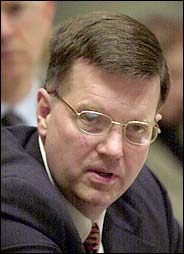
Pete Nanos
Photo credit: Marcio Jose Sanchez/Associated Press |
|
The "cold fusion" faction attempted to marginalize and discredit Widom and Larsen and their theory. And they capitalized on the inroads made by the Widom-Larsen theory, using those newly opened doors to sell "cold fusion" to some people in the government, particularly the DTRA.
I met Bill Wilson of DTRA while he was attending a "cold fusion" session at one of the APS meetings. Wilson clearly spent time learning about LENR, but the decision making about LENR at DTRA appears to have occurred higher up. According to several government sources, Melich was putting in great efforts to lobby George "Pete" Nanos, the associate director of research and development.
According to government sources who spoke to New Energy Times on condition of anonymity, Melich made forceful and overt attempts to discredit the SPAWAR claims and convince Nanos that "heat and helium-4" were the most crucial lines of LENR research to investigate.
2007 – Low Fluxes of Neutrons Stimulate Discussion
In March 2007, at the American Physical Society meeting in Denver, Colorado, the SPAWAR group cautiously began to report possible neutron signals. Around this time, the group also submitted its paper to a journal.
|
The researchers reported low fluxes but clear evidence of neutrons. These findings are inconsistent with D+D "cold fusion," unless, by some chance, someone conceives of a viable process for a primary D+D "cold fusion" scheme that produces tritium in situ which in turn leads to secondary DT "cold fusion" reactions. The findings are, however, readily explainable as spallation neutrons by a non-fusion mechanism, for example, Widom-Larsen.
The SPAWAR group’s work developed further, and it was replicated at SRI International and the University of California, San Diego. In October 2007, at the 8th International Workshop on Anomalies in Hydrogen/Deuterium-Loaded Metals in Catania, Italy, electrochemist Francis Tanzella reported his replication of the SPAWAR experiment.
"Neutron count above background suggested in at least three experiments," Tanzella said.
In one of these, he observed a neutron signal 14 times greater than background from an electronic detector. Researchers in Russia confirmed this by cross-checking, using a different verification method. According to their mechanical method, the signal was real, though not as strong.
A year later, the SPAWAR group’s paper claiming evidence of energetic neutrons published online on Oct. 1, 2008.
Three months after that, on Jan. 7, 2008, Michael McKubre of SRI International, in a presentation to the leaders of the Bhabha Atomic Research Center in Trombay, India, said there were "no neutrons" in LENR.
How could he have made such a statement when he and Tanzella had just reported neutrons three months earlier? When the largest team to investigate LENR had, in this very same Indian institution, observed neutrons in LENR two decades earlier?
Two days after McKubre's talk at BARC, I spoke at the Indian National Institute for Advanced Studies. I gave my perspective and discussed the variety of observed neutron signals in the recent experiments. The audience included leaders of India's national laboratories as well as some members of its Atomic Energy Commission. I included neutron data reported by SRI International.
I expected some tension after my talk, but I was unprepared for this: McKubre demanded that I discontinue discussing the neutron signals reported from his lab by Tanzella at the Catania conference. A copy of Tanzella's slide presentation is here.
"I don't want you showing Fran's graph with the neutron signal anymore," McKubre said. "It's bullshit. I don't believe it."
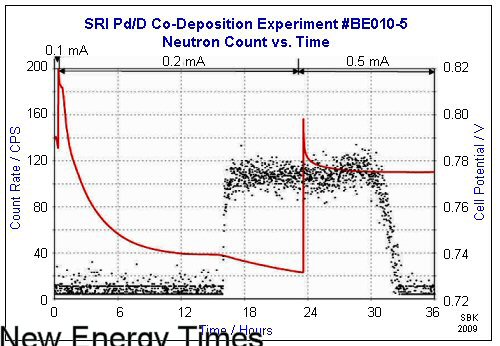
I wanted to know whether there was a legitimate problem with the data reported by Tanzella. After a lengthy follow-up discussion with McKubre in which he confirmed the above quotation, I learned that neither McKubre nor Tanzella had issued any form of retraction or correction for the neutron-signal data. Nor did they give me a single indication of any known correction. I also confirmed with McKubre and Tanzella that I had not misrepresented the neutron-signal data seen at SRI. In an e-mail, McKubre stated that he was confident about the electronic detector.
"Fran[cis Tanzella] reported a clear, clean and unusual response of a detector that has worked for us pretty reliably and for which we have developed a level of trust over many years of observation," McKubre wrote.
Months later, in Moscow, Russian researchers Andrei Lipson and Alexei Roussetski analyzed permanently recorded signals from the same experiment using an entirely different detection tool, solid-state nuclear track detectors, and confirmed an unambiguous neutron signal.
2008- Storms and Hagelstein "There are No Neutrons"
Longtime "cold fusion" researcher, advocate and author Edmund Storms objected to discussion about neutrons in LENR. On Oct. 18, 2008, Storms sent the following message to the CMNS e-mail list:
"I'm confused about a discussion based on neutron emission from LENR. All of the published values for the flux of neutrons are near the sensitivity limit of the detector, if any are detected at all. Why are we now finding a flux high enough to warrant discussion? If neutrons are actually being emitted, they will produce all kinds of isotope changes that will result in beta decay. Such beta decay has not been observed, except on a few occasions, even though it would be easy to detect. What is the point of wasting time speculating on such reactions when no evidence exists for significant neutron emission?"
In fact, researchers were finding a flux high enough to warrant discussion.
The SPAWAR group’s researchers were seeing nuclear particle tracks on the backside of their solid-state nuclear track detectors inexplicable by anything other than neutrons.
Eleven days after Storms sent his message to the CMNS list, on Oct. 29, 2008, Peter Hagelstein gave a presentation at MIT about "cold fusion." Hagelstein, too, said that there were "no neutrons" in LENR.
Neutrons, whether spallation neutrons (secondary reactions) resulting from ultra-low-momentum neutrons (primary reactions) or from some other unexplained reaction, are inconsistent with the D+D "cold fusion" hypothesis, which McKubre, Hagelstein and Storms have so vigorously defended in this past decade.
April 2009 - 60 Minutes Showcases "Cold Fusion"
The April 19, 2009, broadcast of CBS Television's "Cold Fusion Is Hot Again," helped get the attention of the Defense Intelligence Agency, as DIA analyst Beverly Barnhart noted in her Nov. 13, 2009, report. That, in turn, helped to get the attention of the Army Research Laboratory.
CBS producers Sam Hornblower and Denise Cetta decided to focus the program on "excess heat" and promote it as "cold fusion" rather than LENR, without mention of any neutrons, energetic charged particles or alternative explanations for "cold fusion."
They also decided to focus entirely on a single "cold fusion" research company, the former Energetics Technologies laboratory in Israel, to highlight an example of the field. Singling out sources to feature is standard practice for journalism; when we are looking to report good news, we seek the best examples of the subject we can find.
About two years earlier, two of the principals, Irving Dardik and Alison Godfrey, asked me to help them generate publicity so they could better impress their benefactor, Sidney Kimmel, who, according to Godfrey, was losing confidence in Dardik's "SuperWave Fusion" idea. I told them that would not be appropriate for me, and I suggested they hire a publicist.
On May 17, 2008, an entire year before the CBS show aired, Godfrey told me that they were working in some unspecified capacity with 60 Minutes.
"We are a go with 60 Minutes. ... The final yes is dependent on two key people getting permission to go on air. It is VERY good news," Godfrey wrote.
In August 2008, at the ICCF-14 conference, I met Rick Kramer, who introduced himself to me as a "media manager." Throughout much of the first two days of the conference, I saw CBS spend a lot of time talking with Kramer, Dardik, Godfrey and the Energetics Technologies researchers. I don't recall seeing CBS speak to any other researchers.
As a postscript to the CBS "Cold Fusion Is Hot Again" show, New Energy Times has learned that the Energetics lab, according to a government source who was not authorized to speak on the record, lost its funding and closed its doors sometime in October or November 2009. In April 2010, LENR researcher Akito Takahashi wrote that McKubre told him that the Energetics scientists are moving to the University of Missouri, to a lab under the direction of Rob Duncan, the independent expert hired by 60 Minutes.
CBS put in great effort to investigate and report on excess heat. The network found highly competent and qualified researchers to feature, and for this, they did a superb job. But did they miss the larger picture?
| Did CBS know about the SPAWAR neutron story that later, in March 2009, got worldwide attention in the news media? Yes. Did CBS know about alternative explanations for "cold fusion"? Yes. One of its first hired experts, Paul Michael Grant, contacted me on Dec. 28, 2008, to ask my advice for the show. Grant describes himself as follows: "Visiting Scholar, Applied Physics, Stanford (2005-2008), EPRI Science Fellow (Retired), IBM Research Staff Member Emeritus."
"I’ve learned that I might be one of the 'talking heads' ... on Sam’s upcoming production," Grant wrote. "I’m off to CBS News in a couple of weeks for an interview. I’d like to give you a call sometime soon (like in the next five days!) to get your input on 'what’s new and important' in the field of CF. I imagine your 'doesn’t look like fusion' has gotten you some interesting responses from your community."
After I had a lengthy phone call with Grant on Dec. 30, 2008, I sent him and Hornblower a follow-up e-mail.
"Do not make the erroneous assumption that, just because LENR proponents have the same goal [of clean energy], they are all fighting [alongside one another]," I wrote. "If you underestimate the factionalism that exists, you will be misled."
|
|
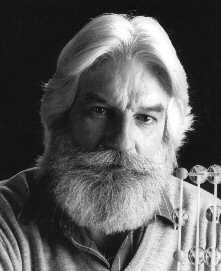
Paul Grant Calls Himself: "Top Science Gun For Hire"
|
My e-mail to Grant continued:
"Why have you and Sam been directed (until now) to only one Navy group, NRL, which, in the last 17 years, has published just one paper on LENR? And it's not even their original work, but a review of the work of others? Not only that, but there are serious omissions in the Hubler paper (Navy China Lake, Navy SPAWAR). ... On the other hand, you've got the SPAWAR group: 20 published papers on LENR, all of their own original research. [The fact] that Denise Cetta is talking with SPAWAR is a very good sign. [The fact] that [you] hadn't been told about the SPAWAR work is a bad sign."
I wrote a follow-up e-mail to Grant, copied to Hornblower and Richard Garwin:
"I remember a conversation I had with Dick about the reproducibility problem a few years ago. I really couldn't argue with Dick about reproducibility and its importance. I asked him for his definition. I remember it clearly: ‘It has to happen more often than not.’
"The consortium's paper from the 2008 ACS book shows excess-heat runs that were reproducible. But the ‘64a and 64b’ pair (reported in 2004) were not reproducible in Dick's definition or in mine. Why would 60 Minutes have any interest in a non-reproducible effect when there are other more-reproducible experiments to consider?
"I encourage you and Sam to look at the big picture. I don't want to see CBS shoot itself in the foot."
Frank Gordon, now retired from SPAWAR, told New Energy Times that CBS did, in fact, meet and speak with them.
"[However,] a few days before [the CBS program] aired," Gordon wrote, "I got a call from one of the editors telling me that we would not be part of the story. He gave two reasons: one, that there wasn't enough time to cover both heat and neutrons, and two, that since we wouldn't go on camera, they didn't feel they could say much about neutrons."
A month before the 60 Minutes program aired, on March 27, the Discovery Channel's Brink covered the SPAWAR neutrons story in six minutes without needing SPAWAR to either go on camera or be quoted on the record.
I do not know why CBS made the choices it did. What I do know is that Alison Godfrey, a principal of Energetics Technologies, strong-armed me to prevent me from meeting the CBS crew.
I have always tried my best to maintain friendly relationships with other journalists who have shown an interest in LENR, though I also make sure they know that I won't hesitate to publicly criticize them if they get the story wrong. On the first day of the ICCF-14 meeting in Washington, D.C., I saw a film crew at the back of the meeting hall. At a break, I walked out of the room, and just outside the doors, in the hallway, Godfrey and several Energetics people were standing and chatting.
Hornblower, whom I later got to meet, was there, too, so I offered my card to him. When my arm was stretched out with my card in hand, Godfrey grabbed my upper arm and dragged me about 10 feet away. She told me, angrily, "You'll meet him later!" A few hours later, Godfrey came up to me and told me that she was angry at me for rudely interrupting their meeting.
August 2009 - DIA
In August 2009, Beverly Barnhart, an analyst with the Defense Intelligence Agency, conducted a workshop at SPAWAR Pacific to learn about LENR. I received a copy of her Technology Forecast report indirectly on Nov. 13, 2009. I called her up and spoke with her for about two hours. I asked her how the whole idea of a workshop and report came about; I asked her some specific questions about theory, the invited speakers and how the report was written.
I was particularly fascinated by the omission of the Widom-Larsen theory and, for that matter, any mention of weak-interaction ideas. Her report stated that "no one theory currently exists to explain all the observed LENR phenomena." She wrote that some researchers think it could be D+D fusion, other researchers think it could be from "non-nuclear means," and that another possibility was "an intricate combination of fusion and fission."
I had chatted on the phone with Pat McDaniel, who was one of the invited speakers at the workshop. As of last year, McDaniel was a research professor with the University of New Mexico. Before that, he had a career in the U.S. Air Force and Sandia National Laboratory.
McDaniel either took it on himself or was asked to provide a critical review of the Widom-Larsen theory at this meeting. Why? Because in McDaniel's view, "Widom Larsen Theory is currently considered by many [people] in the government bureaucracy to explain LENR." McDaniel does not appear to have experience in particle physics or condensed matter nuclear physics.
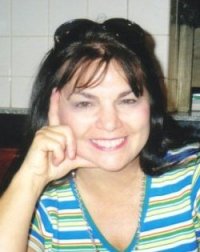
Beverly Barnhart |
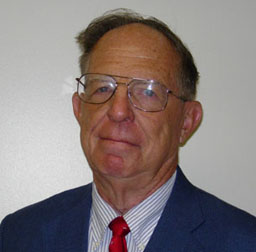
Patrick J. McDaniel |

First two bullets from second slide of Pat McDaniel DIA presentation at SPAWAR, San Diego.
McDaniel knew that Larsen would not be at the workshop. Hagelstein attended the workshop.
2009 - Hagelstein "There are No Energetic Particles"
The SPAWAR group had reported rigorous, repeatable evidence of energetic charged particles and neutrons. These were inexplicable by any D+D "cold fusion" theory Hagelstein might have had.
In November 2009, Hagelstein submitted a paper for publication with theoretical "constraints" speculating that the energetic charged particles were coming from secondary reactions of D+D "cold fusion."
If he could provide a viable explanation for D+D "cold fusion," he might be able to explain secondary reactions that created the energetic charged particles.
2010 - SPAWAR Group Claims DT Fusion
On July 7, 2010, the SPAWAR group published another paper in its long line of LENR research. However, despite the fact that the SPAWAR group was aware that the Widom-Larsen theory provides a mathematically correct and conventional physics-based explanation for a primary source of LENR neutrons, the group did not list this idea even as a possible explanation for secondary, spallation neutrons.
Instead, the researchers speculated that "the most likely source of neutrons responsible for the triple-tracks is DT fusion inside the Pd lattice."
One problem with their speculation is that tritium is not one of their starting materials. Also of significance is the weak experimental evidence they cite for in-cell tritium. Their entire underlying evidence for tritons is shown in the image below. According to electrochemist Pamela Mosier-Boss, the larger circles are tritons, and the smaller are protons.
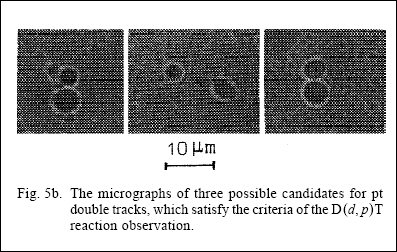
Lipson/Roussetski "Possible candidates for proton-tritium double tracks"
The SPAWAR group floated the idea of DT fusion, yet they provided nothing for theoretical support.
The empirical aspects of the research are very strong, they have made excellent progress to answer previous experimental critiques and they have performed notable work in their attempt to characterize the neutron energies, in collaboration with researchers at a Department of Energy laboratory in Santa Barbara, Calif.
Lost Opportunity
I found that LENR researchers who had anything to say about the Widom-Larsen theory, including many of the experimentalists, were hostile and cynical toward it. Many of them were attached to the hypothesis of "cold fusion."
By 2008, some of the remaining active players in the field had been using the term "cold fusion" for so long that perhaps they couldn't mentally separate the hypothesis of "cold fusion" from the hypothesis of a new nuclear effect.
The "we're all in this together" attitude conveyed by McKubre and the "cold fusion" supporters at ICCF conferences was not holding up. The fight for clean energy seemed less important than the fight for intellectual property and intellectual primacy.
The only formal critique of the Widom-Larsen theory from the "cold fusion" supporters that I am aware of is that by Hagelstein. Many "cold fusion" people provided informal critiques to New Energy Times, and I believe we published every one.
When the Widom-Larsen momentum failed to abate, both at New Energy Times and in the mainstream, the personal attacks against Larsen began. I have seen this pattern frequently in controversial science; when bitter opponents of a new scientific idea fail to impede the growing acceptance of that new idea with scientific argument, they attack the person.
John Burdon Sanderson Haldane, a geneticist and evolutionary biologist born in 1892, also had a perspective on new theories:
|
Theories have four stages of acceptance:
- this is worthless nonsense,
- this is interesting, but perverse,
- this is true, but quite unimportant,
- I always said so.
|
The attacks have targeted Larsen because he was the originator of the Widom-Larsen theory and he is driving its progress. For a detailed background on the development of the theory, see "Development of the Widom-Larsen Theory of LENRs" in this special report.
Before his and Widom's pre-print appeared on May 2, 2005, the LENR community did not yet know he was working on a nonfusion theory and Larsen seemed to be on friendly terms with most of the LENR researchers.
Factionalism
The LENR paradigm, bolstered by the Widom-Larsen model, fueled an undercurrent of factionalism between people who identified themselves with "cold fusion" and those who did not. This battle has been taking place beneath the surface for several years.
The "cold fusion" faction includes McKubre, Hagelstein, Melich, Nagel, Hubler, Scott Chubb, Talbot Chubb, Storms, Violante, Godfrey, Dardik and their supporters, including Jed Rothwell.
The LENR faction comprises Larsen and Widom, a few other researchers, and their supporters, including me. Most of the Widom-Larsen supporters have steered clear of the conflict and kept a low profile.
Infinite Energy magazine founder and editor Eugene Mallove had seen the beginnings of the "cold fusion" factionalism. He saw that a "mainstream," which had started to ostracize nonconformists, had developed within the LENR field, much in the same way that mainstream science had ostracized "cold fusion" in 1989.
Much of this factionalism has flown under the radar because the "cold fusion" faction has been acting in more insidious ways than the 1989 "cold fusion" critics.
For example, at the March 2009 ACS meeting in Salt Lake City, Peter Hagelstein of MIT and Scott Chubb of Infinite Energy magazine speculated that possible instrument error or some kind of imaginary processes were responsible for reported transmutations of palladium to silver, which contradicts their “cold fusion” theories. Vague speculations are the hallmark of pathological skepticism.
Other people, like NRL researchers David Kidwell and Kenneth Grabowski, have suggested, for example, that Iwamura's transmutations are not real LENR transmutation effects but the result of "contamination" by human hands and "lucky tweezers."
When the "cold fusion" faction saw that it was losing ground to the LENR faction, the former suggested that the distinction was mere semantics. When that didn't fly, the faction said that nonfusion reactions could also be defined as fusion. This fallacy is explained in "Neutron Capture Is Not the New Cold Fusion" in this special report.
As the tensions heightened in 2009 and 2010, one of the less-outspoken "cold fusion" theorists, Xing Zhong Li, asked me on March 16, 2010, to hold back my growing skepticism about "cold fusion."
"CMNS is too weak to be split now," Li wrote.
The leaders of the "cold fusion" faction controlled the 2004 Department of Energy review of LENR. They controlled what went into the 2009 Defense Intelligence Agency report. They controlled the politics and funding for the field at NRL, DTRA and DARPA. They have been among the peers asked to review papers. (The field is so small that anonymity is close to impossible.) They now control the recently "cold fusion"-friendly journal, Naturwissenschaften. And they have controlled the last two ICCF conferences.
Control of the conferences means setting the agenda, choosing the scope, deciding on the featured (plenary) speakers, deciding who gets an oral presentation and who gets a board to mount a poster on, and deciding which of the non-plenary speakers get a 10-minute speaking slot, a 15-minute slot or a 20-minute slot.
It also has meant determining which speakers have been sponsored to come to the conferences. One U.S. LENR researcher who supported the "cold fusion" faction's agenda and who wishes to remain anonymous told New Energy Times he was paid $4,000 by Nagel and Melich to attend ICCF-14 and write a review paper. Another unprofessional action of the U.S. ICCF-14 organizers was that they informed speakers of the day and time of their talks only 12 days before the conference. This had the most significant impact on international researchers. For most science conferences that draw international attendees, this information is determined months in advance to enable them to schedule their travel plans more precisely rather than having to block out an entire week for a single 10- to 20-minute talk.
Change?
I don't know what will happen at ICCF-16 in India next year. I do know that the Japanese, Chinese and Indians are taking LENR transmutations seriously and SPAWAR is likely to continue its winning streak. If NRL management gets an infusion of courage, it will seek new people in its ranks who will be eager to succeed.
From a nonscientific perspective, nothing is wrong with the ideal of "cold fusion." It represents hope over hopelessness, clean energy over environmental destruction, and abundant energy over scarcity. This ideal has inspired and motivated scientists to persevere, benefactors to sustain and observers to maintain vigil over this new science that may foreshadow unimaginable new technologies.
⇐ Previous Article — Table of Contents — Next Article ⇒ | 
